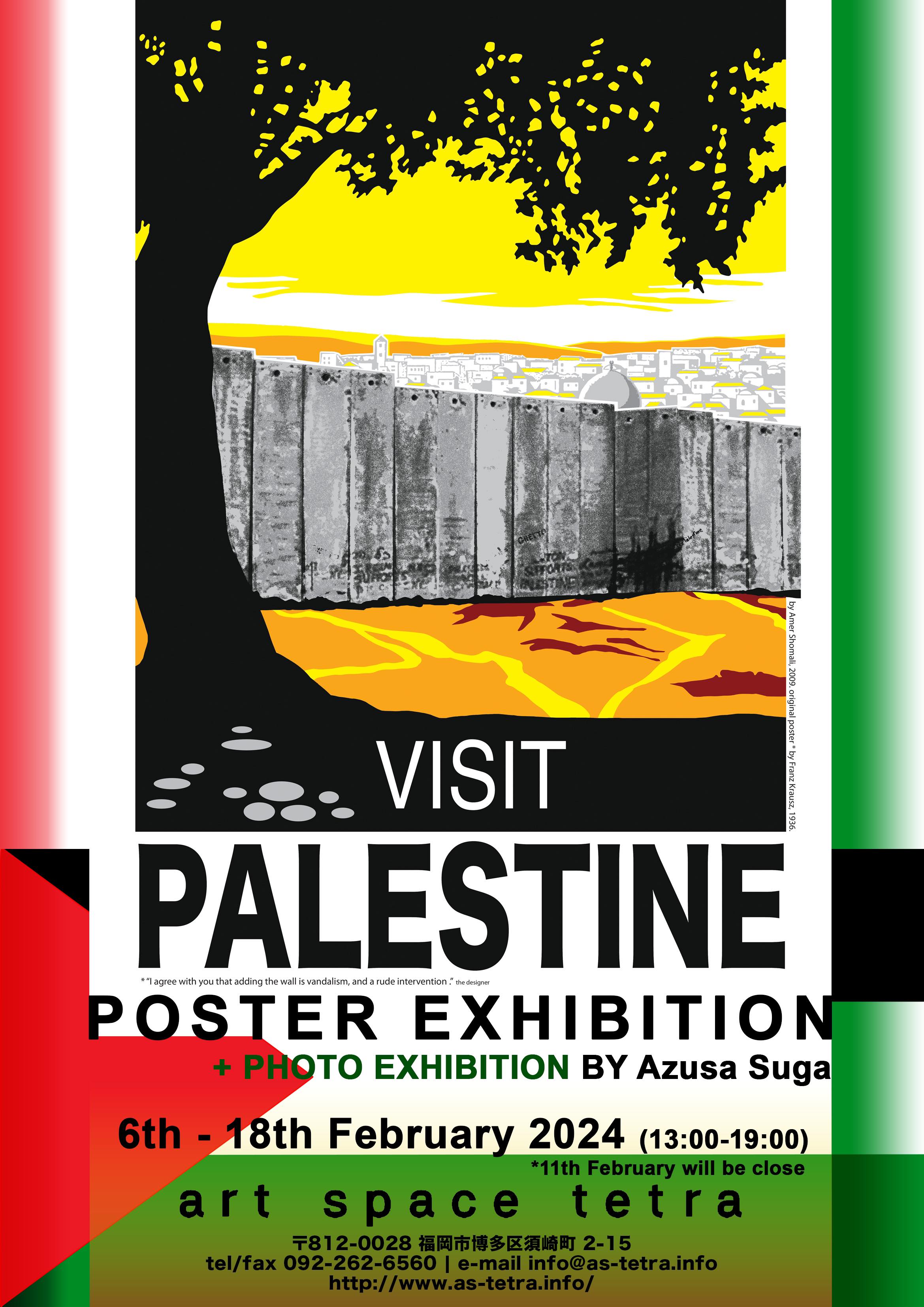
modified : 2024.02.25 12:19
【Duration】 6 Feb (Tue) - 18 Feb (Sun), 2024. *Closed on Sun 11 Feb.
【Opening hours】13:00-19:00
10, 15 Feb → 15:00-19:00
18 Feb → 18:00 (Close)
【Admission】 by donation (all donations, except for necessary expenses, will be used to support Palestine).
【Venue】art space tetra
【Event】
Opening & Talk
Tuesday 6 February 18:00- 19:30
Guest: OSAMA ELJAMAL (Kyusyu University) , Andhika Faisal (SUB STORE, Tokyo),
SUGA Azusa (Photographer)
Moderator:EGAMI Kenichiro (art space tetra)
【期間】2024年2月6日 (火) - 2月18日 (日) ※2/11 (日)は終日休廊
【時間】13:00~19:00
10日(土)15日(木)→15:00-19:00
18日(日)→18時終了
【入場料】カンパ制 (カンパは必要経費を除いて全額パレスチナ支援に充てさせてもらいます)
【会場】art space tetra
【イベント】
①オープニング&トーク
2月6日(火)18:00-19:30
ゲスト:エルジャマル オサマ (九州大学准教授)、アンディカ ファイサル (SUBSTORE 店主)、菅梓(写真家)
司会:江上賢一郎 (tetra運営メンバー)

Exhibition of Palestine Posters "VISIT PALESTINE PROJECT"
Since 1948, Palestine has been subjected to occupation, expulsion, and attacks by Israel. In the Gaza Strip, since 2002, the movement, goods, and lifelines of the people have been controlled by Israel through the separation wall. On the West Bank, Palestinian lands, homes, and communities have been seized through armed settlements. Following the cross-border attack by Hamas on October 7, the Israeli military's daily airstrikes and ground invasions have resulted in the deaths of over 23,000 people (including children and women as victims exceeding 10,000), with over 60,000 injured. More than two million people inside the separation wall face continuous attacks by the Israeli military, along with the destruction of social infrastructure, including water, power facilities, and hospitals, leading to ongoing exposure to famine and epidemics.
The cause of the inhumane situation faced by the people of Palestine is, before anything else, rooted in Israel's settler colonialism, apartheid, and ethnic cleansing, preceding historical and religious issues. To raise awareness of the plight of the Palestinian people and to garner support, the exhibition "VISIT PALESTINE PROJECT" will showcase original posters from the protests against the Palestine wars from the 1970s to the present. The purpose of this exhibition is to widely inform people that Israel's Zionist government has been perpetuating endless occupation and injustice against Palestine for over half a century. It aims to create a platform for citizens to discuss and take action to stop this massacre and occupation.
The venue will feature a photo exhibition on Palestine by photographer Azusa Suga, based in Fukuoka, as well as Palestinian solidarity prints (woodblock printing) by the Asian Woodcut Network, an exhibition of solidarity patches, film screenings, and talks. The goal is to learn about Palestine, say "No" to the ongoing genocide, reflect on what we can do to restore the lives and dignity of the Palestinian people, and take action.
"Why 'VISIT PALESTINE"? - Examining the Background
Lush olive trees, rows of houses, the Dome of the Rock in the Muslim holy land—these are the scenes depicted on a poster boldly proclaiming "VISIT PALESTINE." Designed by Franz Krausz in 1936 amid the Zionist movement aiming for the establishment of a Jewish state, the poster was printed by the Palestine Tourist Association, a Zionist training institution.
Between 1936 and 1948, around 200,000 Jewish immigrants settled in this land. The United Nations, entrusted with addressing the issue by the British mandate, outlined the partition of the Jewish and Arab states. However, for those who had long inhabited Palestine, it was an unilateral decision without any agreement.
Since its establishment in 1948, Israel has expanded its illegal occupation beyond the borders set by the UN. The overwhelming violence of the Israeli state, coupled with the resistance of the Palestinian people, has brought a tragic history to the land where olives grow.
Following the Oslo Accords, which stipulated the mutual recognition between the Palestinian Interim Self-Government Authority and the State of Israel, "VISIT PALESTINE" was nearly reprinted in its original form in 1995 by Israeli designer David Tartakover. Posters, including unauthorized reproductions, displayed on street corners created an atmosphere of fleeting optimism for peace. However, for those who had continuously lost their land, lives, and dignity, it served primarily as a compelling historical document proving the deceit of Zionism.
"Once, this was a desert. It was below undeveloped. There was nothing." (Former Israeli Prime Minister, Eshkol)
"There were no Palestinians. Such people never existed in the first place." (Same, Meir)
These revisionist statements about history, bathed in sunlight after 59 years on the poster, vividly contradicted the claims. "VISIT PALESTINE" thus became an expression of resistance against the State of Israel.
【About VISIT PALESTINE PROJECT】
Current activities of the VISIT PALESTINE PROJECT | Relations – A project of critique and media practice (relations-tokyo.com)
https://www.instagram.com/visit.palestine_project
パレスチナポスター展「VISIT PALESTINE PROJECT」
パレスチナでは1948年から現在までイスラエルによる占領と追放、攻撃が続いてきました。ガザ地区は2002年以降分離壁によって人々の移動、物資、ライフラインがイスラエルの統制下におかれ、西岸では武力を伴った入植によってパレスチナの人々の暮らしている土地、住処、コミュニティが奪われてきました。そして10月7日のハマスによる越境攻撃以降、イスラエル軍による連日の空爆と地上侵攻によって、これまで(2024年1月現在)子ども、女性を含む2万3千人を超える人々が殺され(子どもの死者は1万人以上)、6万人以上が負傷、200万を超える人々が分離壁の内側でイスラエル軍による攻撃、そして水道、発電施設、病院を含む社会インフラの破壊とそれによって引き起こされた飢餓、疫病に晒され続けています。
パレスチナの人々の置かれた非人道的状況の原因とは、歴史問題や宗教問題以前に、イスラエルによる入植型植民地主義、アパルトヘイト、民族浄化の帰結に他なりません。このようなパレスチナの人々の状況を多くの方に知っていただき、また支援を募るため、本展「VISIT PALESTINE PROJECT」では1970年代から現在までのパレスチナ戦争抗議ポスター原画を展示します。昨年末から大阪、京都と続くこの巡回展の目的は、まずイスラエルのシオニスト政府によるパレスチナへの果てしない占領と不正が半世紀以上続いていることを広く知ってもらうこと、そしてこの虐殺と占領を止めるための話し合い、アクションを市民自身で考え実行していく場をつくることです。
会場では福岡を拠点に活動する写真家、菅梓によるパレスチナ写真展をはじめ、アジアの木版画ネットワーク「Solidarity for Palestine」によるパレスチナ連帯版画(印刷)、新宿のインフォショップ「Irregular Rhythm Asylum」提供のポスター群、連帯パッチの展示、映画上映、トークも予定しています。パレスチナについて知ること、そして現在進行中の虐殺に「No」を突きつけること。そしてパレスチナの人々の生活と尊厳を取り戻すため、私たちに何ができるのか考え、行動していく場にしたいと考えています。
【解題:なぜ “VISIT PALESTINE”なのか?】
豊かに繁るオリーブの木。建ち並ぶ家々。ムスリムの聖地、岩のドーム。「VISIT PALESTINE」と大きく記されたポスターは、1936年、ユダヤ人国家建設を目指すシオニズム運動のなかでフランツ・クラウスがデザインし、シオニスト育成機関であるパレスチナ観光協会によって印刷された。
1936年から1948年にかけて、この地に移り住んだユダヤ人は約20万人にのぼる。旧委任統治国の英国から対処を託された国連は、ユダヤ人国家とアラブ人国家の分割を定めたが、それは永くこのパレスチナに暮らしてきた人々にとって、なんの合意もない一方的な決定だった。
1948年の建国以降、国連が提示した「国境線」をも越えて不法な占拠を拡大するイスラエル国家の圧倒的な暴力と、パレスチナ人の抵抗は、オリーブの育つ土地に凄惨な歴史をもたらした。
パレスチナ暫定自治政府とイスラエル国家の相互承認を定めたオスロ合意を受けて、1995年「VISIT PALESTINE」はイスラエルのデザイナー、デビッド・タルタコーバによってほぼオリジナルのまま刷り直された。無許可の複製物も含めて街角に貼られたポスターは、楽観的な平和のムードも束の間漂わせたが、土地と生命と尊厳を奪われ続けてきた人々にとって、なによりそれはシオニズムの欺瞞を証明する格好の歴史資料だった。
「ここは砂漠だった。未開発以下だった。何もなかった」(イスラエル元首相、エシュコル)
「パレスチナ人などいなかった。そんな人間はもとから存在しなかった」(同、メイア)
歴史を改竄するこれらの言説を、59年ぶりに陽を浴びたポスターは、鮮やかに否定した。そして「VISIT PALESTINE」は、イスラエル国家に対する抵抗の表現となった。
【about VISIT PALESTINE PROJECT】
VISIT PALESTINE PROJECTの現在地 | Relations (リレーションズ)批評とメディアの実践のプロジェクト (relations-tokyo.com)
https://www.instagram.com/visit.palestine_project